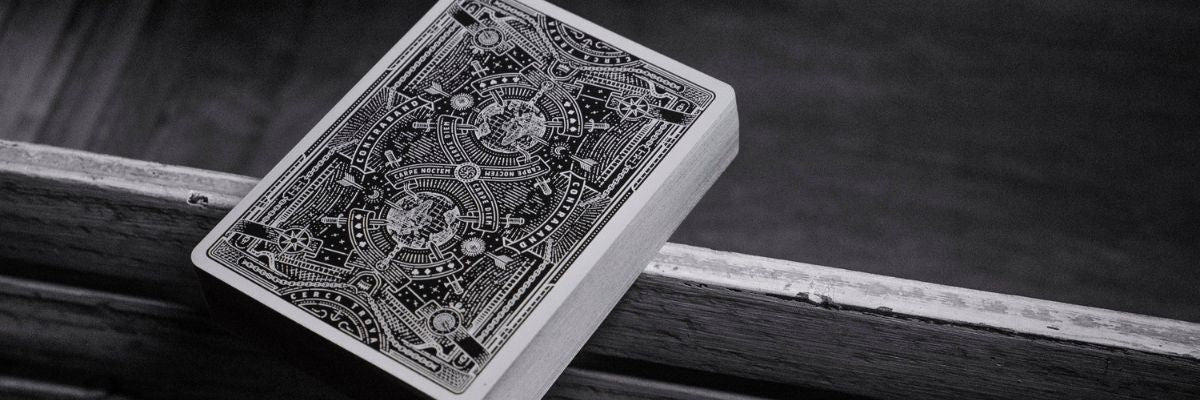How to Play Crazy Eights
Also known as: Eights, Swedish Rummy, Last Card, Mau-Mau, or Switch (UK version)
Overview
Crazy Eights is a fast-paced card shedding game where players race to be the first to get rid of all their cards. It’s simple to learn, quick to play, and a perfect card game for 2–6 players.
If you’ve ever played Uno, you already know the basics, Uno was directly inspired by Crazy Eights! Crazy Eights was in turn inspired by Mau-Mau.
Objective
- Be the first player to get rid of all your cards
Its as simple as that, but you’ll need to outsmart your opponents by matching, blocking, and changing suits along the way.
What You’ll Need
• One standard 52-card deck (remove the jokers)
• 2–6 players
• A table or flat surface
The game feels more fun when its fast paced, so choose a deck that’s easy to read at a glance. Highly decorative or ornate cards can look beautiful, but they sometimes make it harder to spot suits in the heat of play.
The Set up
- Shuffle the deck.
- Deal 5 cards to each player (or 7 if only two are playing).
- Place the remaining cards face-down in the centre as the draw pile.
- Turn over the top card from the draw pile to start the discard pile.
How to Play
- The player to the dealer’s left goes first.
- On your turn, you must play a card that matches the top card of the discard pile, either by suit or rank.
- Example: if the discard pile shows the 7♦, you can play any 7 or any diamond.
- Exception: Eights don’t count as matching numbers. They are wild cards and can be played at any time, even if they don’t match the suit or number of the top card.
- If you can’t play, draw cards from the draw pile until you can (or draw one and pass, depending on house rules).
- When you play an 8, you must declare the suit that the next player must follow. For example, “Clubs!” means the next card played must be a club.
Winning the Game
- The first player to play all their cards wins the round.
- If you want to keep score, the winner scores points equal to the total of all cards remaining in other players’ hands.
- Number cards = face value
- Face cards (J, Q, K) = 10 points each
- Eights = 50 points
- Play to a set score (often 100 or 200) to determine the overall winner.
Common Variations
Different regions and families have their own tweaks / house rules, here are a few of the most popular:
| Variation | Rules |
| Switch (UK) | Uses the same principle, but special cards have added effects. E.g. 2s make the next player pick up two, 8s skip a turn. |
| Mau-Mau (Europe) | Often played with 32-card German decks; Jacks are wild instead of 8s. |
| Last Card Rule | Players must announce when they have one card left, if you forget, you draw two! |
| Double Deck | Two decks combined for bigger groups or longer games. |
Strategy Tips
- Keep an 8 for emergencies, it can save you when you have no matching suits.
- Watch which suits are being declared, you might predict what others are holding.
- Try to force opponents to draw by changing suits often.
A Little History
The roots of Crazy Eights can be traced back to early 20th-century Europe, where a similar game called Mau-Mau was already being played, especially in Germany and Austria. Mau-Mau used a smaller deck (usually 32 cards) and featured Jacks as wild cards, allowing players to change suits.
During the 1930s and 1940s, the game crossed the Atlantic and evolved into the version we know today. American players adapted it for a standard 52-card deck, replacing the wild Jacks with Eights, and from there, Crazy Eights was born.
The name itself likely came from “Section 8”, a US military term used during World War II for soldiers discharged due to mental instability, a tongue-in-cheek reference to the game’s unpredictable twists and turns.
As the game spread worldwide, local variations emerged. In the UK, it evolved into Switch, where certain cards trigger extra actions (like making the next player pick up two). In Germany and much of Europe, the original Mau-Mau name stuck.
Fun Fact
Did you know that Mattel’s UNO, released in 1971, was created by a barber in Ohio who loved Crazy Eights but wanted more structured “action cards”? UNO is essentially a commercial evolution of this classic family favourite.



